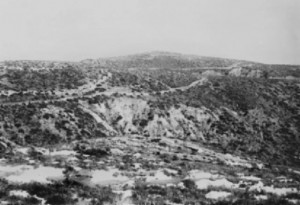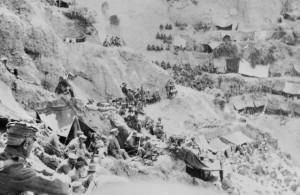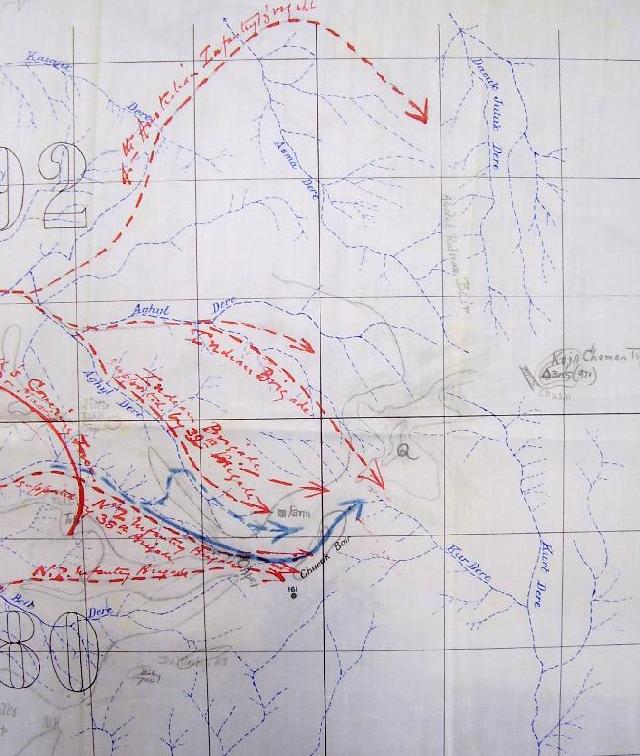The Thrust for Hill 971
 This month we complete our coverage of the major ANZAC actions during the August Offensive at Gallipoli, with a look at the thrust by Monash’s 4th Australian Infantry Brigade to seize the highest point in the Sari Bair range – Hill 971.
The plan for the August Offensive, as far as operations mounted out of the ANZAC perimeter, was complicated. Following the 1st Australian Brigade attack at Lone Pine on the evening of 6 August, there was to be a series of coordinated flanking actions with the common goal of gaining all the high ground to the north-east of the ANZAC sector. This would break the stalemate that had existed since April and reintroduce manoeuvre to the campaign.
In the May Battlefield News we saw the opening moves, when the New Zealand Mounted Rifles (NZMR) cleared the Turkish outposts overlooking the approach route around the northern flank. At the same time battalions of the British 40th Brigade, reinforcing the Anzacs, were to establish a flank-guard on Damakjelik Bair, further north. This would cover the move of the 4th Australian and the 29th Indian brigades, under the overall command of Major General Cox, up the Aghyl Dere, a large gully leading inland from the coastal plain. Not only did this provide a route to the 971 feature, but it also guaranteed separation from the New Zealand Infantry Brigade, at this time struggling up Rhododendron Ridge to Chunuk Bair.
The overall plan for the night actions of 6 August, aimed at putting ANZAC and British troops on top of the three main features - Chunuk Bair, Hill Q and Hill 971 - by dawn on the 7th, depended heavily on adherence to a strict timetable. Cox’s time and space calculation called for the move from the ANZAC perimeter to commence at 9.45 pm, once the Kiwis had cleared the nearer Turkish outposts. He expected to be on the major spur leading to Hill 971 - Abdul Rahman Bair - by 2.00 am on 7 August, leaving two hours for the capture of the features. However, events began to affect timings from the outset. The NZMR’s preliminary operation to clear the outposts took longer than planned. This delayed the departure of the 40th Brigade flank guard units, in turn holding up Cox’s force on the foreshore.
This month we complete our coverage of the major ANZAC actions during the August Offensive at Gallipoli, with a look at the thrust by Monash’s 4th Australian Infantry Brigade to seize the highest point in the Sari Bair range – Hill 971.
The plan for the August Offensive, as far as operations mounted out of the ANZAC perimeter, was complicated. Following the 1st Australian Brigade attack at Lone Pine on the evening of 6 August, there was to be a series of coordinated flanking actions with the common goal of gaining all the high ground to the north-east of the ANZAC sector. This would break the stalemate that had existed since April and reintroduce manoeuvre to the campaign.
In the May Battlefield News we saw the opening moves, when the New Zealand Mounted Rifles (NZMR) cleared the Turkish outposts overlooking the approach route around the northern flank. At the same time battalions of the British 40th Brigade, reinforcing the Anzacs, were to establish a flank-guard on Damakjelik Bair, further north. This would cover the move of the 4th Australian and the 29th Indian brigades, under the overall command of Major General Cox, up the Aghyl Dere, a large gully leading inland from the coastal plain. Not only did this provide a route to the 971 feature, but it also guaranteed separation from the New Zealand Infantry Brigade, at this time struggling up Rhododendron Ridge to Chunuk Bair.
The overall plan for the night actions of 6 August, aimed at putting ANZAC and British troops on top of the three main features - Chunuk Bair, Hill Q and Hill 971 - by dawn on the 7th, depended heavily on adherence to a strict timetable. Cox’s time and space calculation called for the move from the ANZAC perimeter to commence at 9.45 pm, once the Kiwis had cleared the nearer Turkish outposts. He expected to be on the major spur leading to Hill 971 - Abdul Rahman Bair - by 2.00 am on 7 August, leaving two hours for the capture of the features. However, events began to affect timings from the outset. The NZMR’s preliminary operation to clear the outposts took longer than planned. This delayed the departure of the 40th Brigade flank guard units, in turn holding up Cox’s force on the foreshore.
 With the furthest to go, the 4th Brigade was leading the combined Australian and Indian force. They did not recommence the advance until 11.00 pm and things were soon to get worse. The march was proceeding slowly when Major Percy Overton, an NZMR scouting officer who was guiding the 4th Brigade, was persuaded by a local Greek villager to take a shortcut, through a gully (Taylor’s Gap) behind Bauchop’s Hill, into the Aghyl Dere. The column was fired on by Turks on both sides of the gully. While the leading platoons of the 13th Battalion deployed to deal with this threat, the column kept moving slowly forward. Further on, the gully became so narrow and overgrown that the column was forced into single file, then had to cut a passage through the growth.
With the furthest to go, the 4th Brigade was leading the combined Australian and Indian force. They did not recommence the advance until 11.00 pm and things were soon to get worse. The march was proceeding slowly when Major Percy Overton, an NZMR scouting officer who was guiding the 4th Brigade, was persuaded by a local Greek villager to take a shortcut, through a gully (Taylor’s Gap) behind Bauchop’s Hill, into the Aghyl Dere. The column was fired on by Turks on both sides of the gully. While the leading platoons of the 13th Battalion deployed to deal with this threat, the column kept moving slowly forward. Further on, the gully became so narrow and overgrown that the column was forced into single file, then had to cut a passage through the growth.
 Cox had ordered Monash to place his headquarters in the centre of the brigade’s order of march, meaning that he had no control over events at the head of the column. Unable to get information Monash went forward himself, finding the leading battalion (the 13th) halted in the bottom https://www.viagrasansordonnancefr.com/viagra-en-pharmacie/ of the Aghyl Dere. It was now 2.00 am. The detour through the “shortcut” had effectively made the original navigation data, based on compass bearings and distance travelled as measured from the map, redundant. Having reached the Aghyl Dere, the plan called for two battalions (the 13th and 14th) to be detached as flank security, while the 15th and 16th battalions, reinforced by two Indian battalions, moved onto Abdul Rahman Bair and attacked Hill 971.
Cox had ordered Monash to place his headquarters in the centre of the brigade’s order of march, meaning that he had no control over events at the head of the column. Unable to get information Monash went forward himself, finding the leading battalion (the 13th) halted in the bottom https://www.viagrasansordonnancefr.com/viagra-en-pharmacie/ of the Aghyl Dere. It was now 2.00 am. The detour through the “shortcut” had effectively made the original navigation data, based on compass bearings and distance travelled as measured from the map, redundant. Having reached the Aghyl Dere, the plan called for two battalions (the 13th and 14th) to be detached as flank security, while the 15th and 16th battalions, reinforced by two Indian battalions, moved onto Abdul Rahman Bair and attacked Hill 971.
 Now not sure how far up the Aghyl Dere they had come, Monash hurriedly reorganised the 13th and 14th battalions. Estimating, incorrectly, that the mouth of a wide re-entrant on the opposite side of the dere (later named Australia Valley) was the point at which the flank security units should deploy, Monash ordered them off. He then brought up his other two battalions (the 15th and 16th) and sent them forward, supposedly to climb onto Abdul Rahman Bair, while the brigade headquarters was set up in Australia Valley. There was no sign of the two reinforcing Indian battalions. By dawn the two attacking battalions had advanced about 1500 metres, continually in contact with parties of retreating Turks.
At 5.00 am the commanders of the two battalions informed Monash that their men were exhausted. The left of the 15th Battalion had tied in with the flank security positions and, on the right, the 16th Battalion claimed to be on Abdul Rahman. Although Cox wanted an attack launched at 11.00 am, Monash believed it to be impossible. He had been forward and seen the condition of the men. It also appeared that the 16th Battalion was, in fact, not on Abdul Rahman. After a heated argument, Cox agreed that the 4th Brigade could dig in where they were.
By the morning of 7 August results of the offensive were not impressive. Desperate fighting continued at Lone Pine and the attacks at German Officer’s Trench and The Chessboard had failed completely. The New Zealand infantry had not captured Chunuk Bair and so the unsupported attack at The Nek had shattered the 3rd Light Horse Brigade. The Indian Brigade had not secured Hill Q.
In the evening of 7 August Cox told Monash that attacks on all three of the features would be resumed next morning. Monash protested that his men were not capable, but Cox ordered the 4th Brigade to attack Hill 971 at 4.15 am, after a naval bombardment. The commanders of the 14th, 15th and 16th Battalions were given orders at 8.30 pm. Although some reconnaissance was done, no one recognised that the brigade was actually 650 metres short of Abdul Rahman, with the obstacles of both the Kaiajik Dere and the Asma Dere to be crossed before the attack could begin.
It was already 4.15 am before the 15th Battalion struggled onto what was thought, incorrectly, to be a spur running off Abdul Rahman. Crossing an oatfield, the battalion received intense fire from Turkish machine guns on the actual Abdul Rahman, still 500 metres away on the other side of the Asma Dere. As the Turks mounted a counterattack across the Asma Dere, the 14th Battalion joined the survivors of the 15th under cover of the southern slope of the spur. Only the intervention of the 16th Battalion prevented envelopment of the Australian position.
Throughout the action Monash had been at his headquarters in Australia Valley. The telephone line to his forward units, cut by Turkish artillery fire soon after the advance commenced, was not repaired until 7.05 am. This was a serious failure of command and control, leaving Lieutenant Colonel Pope, commander of the 16th Battalion and the senior officer forward, to fight the battle. With the Australians now receiving shrapnel fire from Turkish artillery and new Turkish advances from Abdul Rahman, it was becoming a fight for survival by the Australians. With telephone communications re-established, Pope recommended a withdrawal; Monash and Cox agreed.
By 8.30 am the attack was over. Throughout the morning groups of men made their way back into the new line established by British units around Australia Valley. There were no further attempts to capture Hill 971.
Article written by Rod Margetts - who is a battlefield tour guide for Boronia Travel Centre
Image Top Right: The summit of Hill 971 from Chunuk Bair looking north. (From the CEW Bean Collection).
Image Middle Left: Members of the 4th Brigade attending a church service in Reserve Gully, being conducted by Chaplain A Gillison of the 14th Battalion, prior to the Brigade moving out to take part in the great offensive against Chanuk Bair and Hill 971, 6 August 1915. Source: Australian War Memorial.
Image Middle Right: Portrait of Brigadier General (later General) Sir John Monash KCB, VD. One of Australia's most distinguished soldiers during the First World War. During his Army career, General Monash was Colonel Commanding the 13th Infantry Brigade of the Citizen Forces, Commander of the 4th Infantry Brigade AIF at Gallipoli, Commander of the 3rd Australian Division AIF in France 1916-1918 and Commander of the Australian Corps AIF from 31 May 1918 until after the Armistice. Photo taken October 1915. Source: Australian War Memorial.
Large Image Centre: Hand drawn plan for the attack on Hill 971.
Now not sure how far up the Aghyl Dere they had come, Monash hurriedly reorganised the 13th and 14th battalions. Estimating, incorrectly, that the mouth of a wide re-entrant on the opposite side of the dere (later named Australia Valley) was the point at which the flank security units should deploy, Monash ordered them off. He then brought up his other two battalions (the 15th and 16th) and sent them forward, supposedly to climb onto Abdul Rahman Bair, while the brigade headquarters was set up in Australia Valley. There was no sign of the two reinforcing Indian battalions. By dawn the two attacking battalions had advanced about 1500 metres, continually in contact with parties of retreating Turks.
At 5.00 am the commanders of the two battalions informed Monash that their men were exhausted. The left of the 15th Battalion had tied in with the flank security positions and, on the right, the 16th Battalion claimed to be on Abdul Rahman. Although Cox wanted an attack launched at 11.00 am, Monash believed it to be impossible. He had been forward and seen the condition of the men. It also appeared that the 16th Battalion was, in fact, not on Abdul Rahman. After a heated argument, Cox agreed that the 4th Brigade could dig in where they were.
By the morning of 7 August results of the offensive were not impressive. Desperate fighting continued at Lone Pine and the attacks at German Officer’s Trench and The Chessboard had failed completely. The New Zealand infantry had not captured Chunuk Bair and so the unsupported attack at The Nek had shattered the 3rd Light Horse Brigade. The Indian Brigade had not secured Hill Q.
In the evening of 7 August Cox told Monash that attacks on all three of the features would be resumed next morning. Monash protested that his men were not capable, but Cox ordered the 4th Brigade to attack Hill 971 at 4.15 am, after a naval bombardment. The commanders of the 14th, 15th and 16th Battalions were given orders at 8.30 pm. Although some reconnaissance was done, no one recognised that the brigade was actually 650 metres short of Abdul Rahman, with the obstacles of both the Kaiajik Dere and the Asma Dere to be crossed before the attack could begin.
It was already 4.15 am before the 15th Battalion struggled onto what was thought, incorrectly, to be a spur running off Abdul Rahman. Crossing an oatfield, the battalion received intense fire from Turkish machine guns on the actual Abdul Rahman, still 500 metres away on the other side of the Asma Dere. As the Turks mounted a counterattack across the Asma Dere, the 14th Battalion joined the survivors of the 15th under cover of the southern slope of the spur. Only the intervention of the 16th Battalion prevented envelopment of the Australian position.
Throughout the action Monash had been at his headquarters in Australia Valley. The telephone line to his forward units, cut by Turkish artillery fire soon after the advance commenced, was not repaired until 7.05 am. This was a serious failure of command and control, leaving Lieutenant Colonel Pope, commander of the 16th Battalion and the senior officer forward, to fight the battle. With the Australians now receiving shrapnel fire from Turkish artillery and new Turkish advances from Abdul Rahman, it was becoming a fight for survival by the Australians. With telephone communications re-established, Pope recommended a withdrawal; Monash and Cox agreed.
By 8.30 am the attack was over. Throughout the morning groups of men made their way back into the new line established by British units around Australia Valley. There were no further attempts to capture Hill 971.
Article written by Rod Margetts - who is a battlefield tour guide for Boronia Travel Centre
Image Top Right: The summit of Hill 971 from Chunuk Bair looking north. (From the CEW Bean Collection).
Image Middle Left: Members of the 4th Brigade attending a church service in Reserve Gully, being conducted by Chaplain A Gillison of the 14th Battalion, prior to the Brigade moving out to take part in the great offensive against Chanuk Bair and Hill 971, 6 August 1915. Source: Australian War Memorial.
Image Middle Right: Portrait of Brigadier General (later General) Sir John Monash KCB, VD. One of Australia's most distinguished soldiers during the First World War. During his Army career, General Monash was Colonel Commanding the 13th Infantry Brigade of the Citizen Forces, Commander of the 4th Infantry Brigade AIF at Gallipoli, Commander of the 3rd Australian Division AIF in France 1916-1918 and Commander of the Australian Corps AIF from 31 May 1918 until after the Armistice. Photo taken October 1915. Source: Australian War Memorial.
Large Image Centre: Hand drawn plan for the attack on Hill 971.
This entry was posted in Historical Highlights. Bookmark the permalink.






